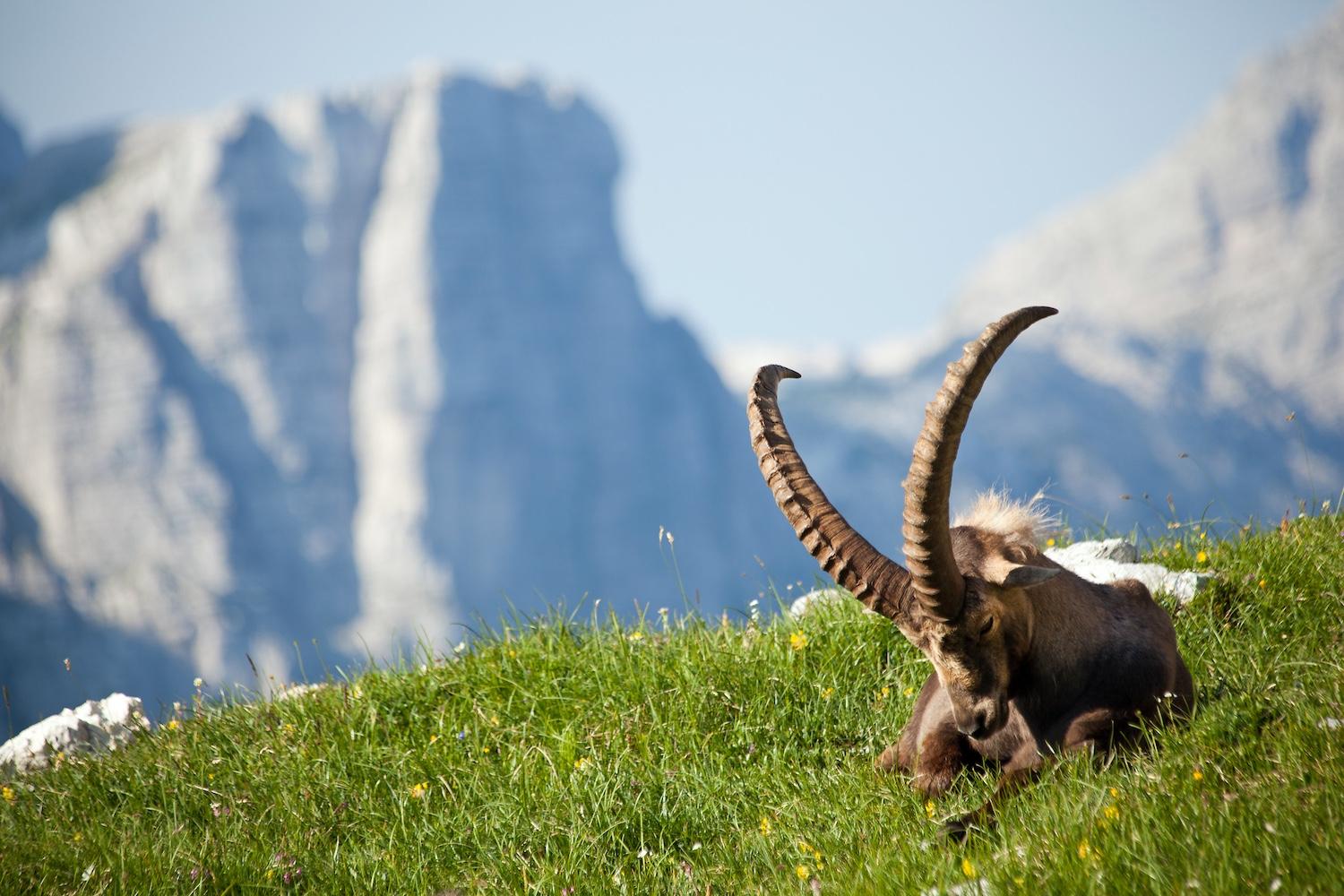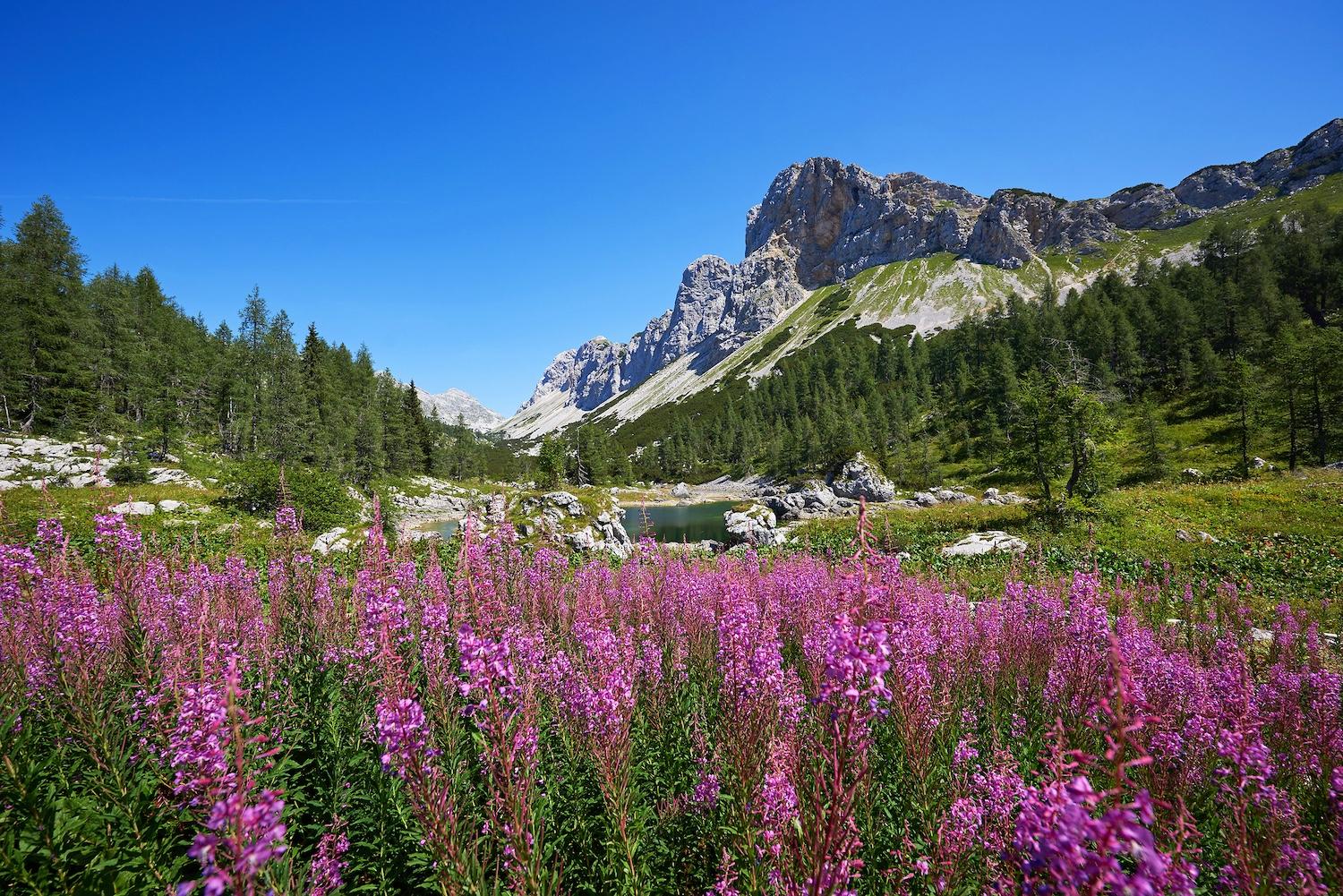Editor's note: Across the globe, there are thousands of national parks and protected areas. To look at how other countries manage and protect their parks, and to introduce you to some incredible destinations, the National Parks Traveler occasionally will post a feature from abroad.
It's not every day when a legend behind a flower explains the physical look of a landscape. Or the healing power of nature (and warning about its ability to avenge). But Slovenia’s most famous legend explains the unusually jagged peaks, about a dozen lakes, glacier-carved valleys and gorges in Triglav National Park, its only national park, as well as the Triglav rose.
An ibex with golden horns, Zlatorog ("golden horn" in Slovene), once lived here. But a greedy hunter, hearing the ibex was the key to hidden treasure, shot it. When the dying animal fell bleeding, flowers sprung up. After eating one, it regained its strength, rampaged over the land, tearing it into the lakes and peaks seen today, and lured the hunter to ever higher ground. Blinded by the sun reflected on the gold, the man tumbled over a cliff and died.

The Triglav Rose/Joze Mihelic
A pinkish-red five-petal flower, the Triglav rose (potentilla nitida) grows from gravel, rocky grasslands and in crevices in summer amid the snow-capped Julian Alps in the park, located in northwest Slovenia near the borders of Italy and Austria. The myth and flower are so well-known in Slovenia, many things bear their names, from the country’s best-selling beer, Zlatorog, restaurants to the Triglavska Roza Bled Info Centre in Bled, a gateway town east of the park. (Bled is in the Julian Alps Biosphere Reserve that encircles the 340-square-mile national park, designated by UNESCO in 2003. In 2024 it was combined with a nearby biosphere in Italy to form the Julian Alps Transboundary Reserve.) In a country known for pristine, magnificent nature, where about one-third of all land is protected, it's fitting indeed.
“Sustainability is not just an option for Slovenian tourism; it is our responsibility to safeguard our natural wonders, rich culture and traditions, which are at the core of our identity,” said Maja Pak, Director of the Slovenian Tourist Board. Slovenia was declared the first “green” country in the world by Green Destinations, a Dutch organization that certifies destinations and businesses who commit to sustainable tourism, in 2016, due to its remarkable 96% compliance rate in 100 sustainability criteria, and ranked #2 in environmental sustainability in the 2024 World Economic Forum Travel & Tourism Development Index.

Europe’s only surviving ibexes were in Gran Paradiso, Italy; all ibexes today descend from them/Jost Gantar
The park is named after its highest peak, 9,395-foot Mount Triglav (“three heads”). The symbol of Slovenia, the three-peaked mountain is so revered, it’s on its flag, which depicts three white peaks, three gold stars and wavy blue lines signifying rivers and the Adriatic Sea against a blue background. Slovenia’s coat of arms, it’s overlaid on white, blue and red horizontal stripes. At the mountain’s top stands Alvaz Tower, a cylindrical flag tower named for the man who designed and donated it, a Slovene priest and mountaineer, Jacob Alvaz. He bought the mountaintop from the town of Dovje, hired a craftsman to build the metal tower, and dragged the metal sheets uphill with his friends in 1895. (He reportedly purchased it for one Austro-Hungarian gulder, equivalent to 50 eggs or 10 liters of milk then, but building it cost him much more.) You can reach it by a three-hour hike to a plateau beneath Mount Triglav, followed by a via ferrata climb.

The Soca River in Triglav National Park, Slovenia/Boris Pretnar
The Soca River is a highlight of the park — so startlingly bluish-green, it seemed surreal to this ex-New Yorker, who grew up thinking rivers were brown like the Hudson. “This was the Isonzo River when I was here during World War II, when Slovenia was part of Italy,” the man next to me said during my first trip to Slovenia. Confiding he was in the U.S. Army’s 10th Mountain Division, the veteran said he spent lots of time skiing, and when he entered villages, locals greeted him warmly. They didn't identify with Italy, then our enemy and Hitler’s ally; Slovenia was part of the Austro-Hungarian Empire until 1920, when it was granted to Italy, and the Slovene language and culture were repressed.
I never heard of the 10th Mountain Division, so when I came home I looked it up, to find ski tourism in the U.S. West was pioneeed by its veterans. He explained how this region was also the frontline of some of World War I’s bloodiest battles, called the Isonzo Front, which Hemingway wrote about in A Farewell to Arms. Staring at the shockingly turquoise Soca River, I found it hard to envision what man wrought on the glorious area. Slovenia became part of Yugoslavia after WW2, and was the first region to declare its independence in 1991.
Vintgar Gorge, a canyon almost 5,000 feet long and up to 750 feet deep, is another highlight of the park. Here a mile-long wooden path leads to Sum Waterfall, where an arched stone railway bridge spans the Radovna River, just two miles northwest of Bled. Other park attractions are Lake Bohinj, Slovenia’s biggest lake, where the Church of St. John, a Gothic church with a Baroque bell tower, is on its east shore, and a sculpture, Four Bold Men, honoring the first ascent of Mount Triglav in 1778.
This year is important for Slovenia: 2024 marks the 100th anniversary of the lease agreement that established the precursor to Triglav National Park, Alpine Conservation Park. A postage stamp of Triglav was issued, and the calendar is packed with events for the park, from guided tours, lectures, exhibits, festivals to markets. Weekly programs through October include guided tours and birdwatching tours in Juliana Alpine Botanical Garden in Trenta and talks on science research at Bled’s Infocenter. Film screenings of In the Kingdom of Zlatorog and Zlatorog, an animated film, exhibits on nature photography, crafts, dairy farming and sheepherding, talks on “green tourism” and photography’s role in nature conservation, and the International Wild Flower Festival in Bohinj, are featured.

Hiking to Triglav Lakes/Tomo Jeseničnik
The 1924 lease agreement was for a much smaller park, about 3,400 acres in the Valley of the Triglav Lakes. It was officially designated Triglav National Park in 1961, and greatly expanded in 1981 and 2010. The park was inspired by a pioneering Slovenian scientist who loved mountain climbing and hiking, Dr. Albin Belar, who in 1907 issued a proposal to protect the gorgeous region he loved. He built an earthquake observatory by his villa near the Vintgar Gorge and invented a seismometer to measure distant earthquakes, named (what else) Zlatorog. But a serious effort to revive his proposal didn’t come until 1920, from the Museum Society of Slovenia, who signed the 1924 lease with the Directorate of Forests in Ljubljana, who managed the land for the Catholic Church, who owned it, and the Slovene Alpine Club. The man nicknamed “King of Triglav” is honored today with annual science activities for grade-school students, called Belar Days.
The park has 1,600 plant species, of which 19 are endemic, found nowhere else, such as Zois’ bellflower (campanula zoysii), tubular purple flowers with puckered tips - the star-shaped mouth is so narrow, insects can’t fit to enter to pollinate it, and need to make a hole – and King of the Alps (eritrichium nanum), a light-blue flower able to withstand harsh wind and cold temperatures. Edelweiss, whose fuzzy white petals surround a cluster of spiky yellow florets (the first protected plant in Slovenia, designated in 1896 due to overharvesting), also flourishes.
More than 7,000 animal species live in the park, from chamois, red deer, brown bear, red fox, golden eagle to the Eurasian pygmy owl, just six to eight inches tall. Ironically, the ibex became extinct because its curved horns (which can be up to three feet long), were prized for medicinal purposes, and it was re-introduced in Slovenia starting in 1964. (Europe’s only surviving ibexes were in Gran Paradiso, Italy; all ibexes today descend from them.) To safeguard its treasures, so the ibex and edelweiss don’t disappear again, tourism issued 10 recommendations for how to behave in the wild for the park.
The iconic photo of Slovenia is a tiny, church-crowned island in the middle of Lake Bled, surrounded by mountains. I’d seen that photo for years, so admiring it in person was a thrill, getting there on a wooden gondola-style boat to see the church, rebuilt in 1465, and its 99 stone steps. So was climbing to Castle Bled, perched atop a 425-foot-high cliff, to view the island. But Slovenia is far more than that popular photo, and exploring Triglav National Park is an ideal way to see its wonders.

The tiny, church-crowned island in the middle of Lake Bled/Franci Ferjan



 Support Essential Coverage of Essential Places
Support Essential Coverage of Essential Places







Add comment